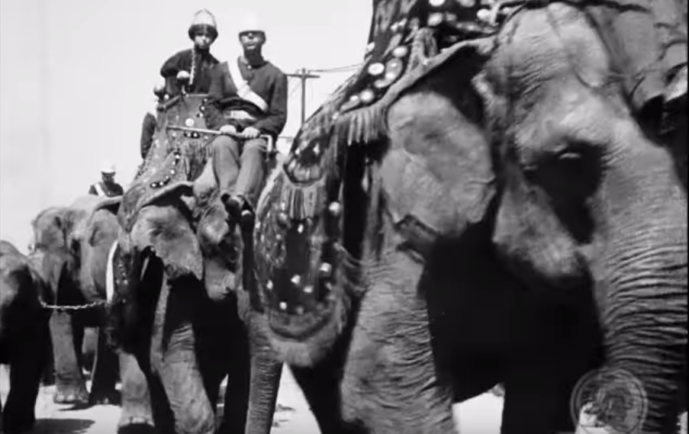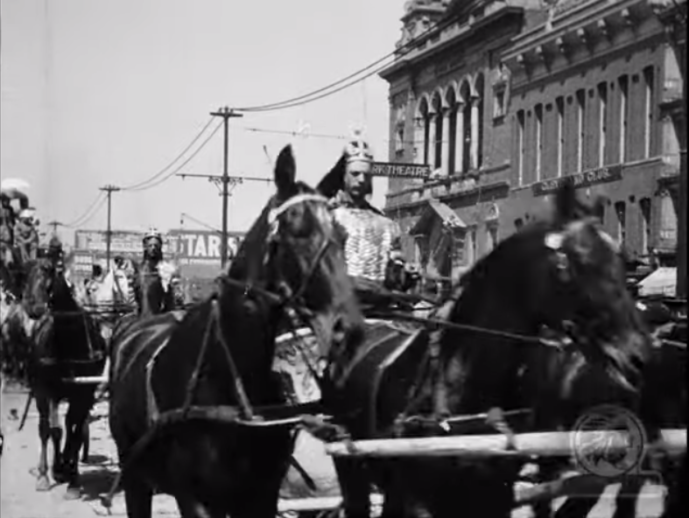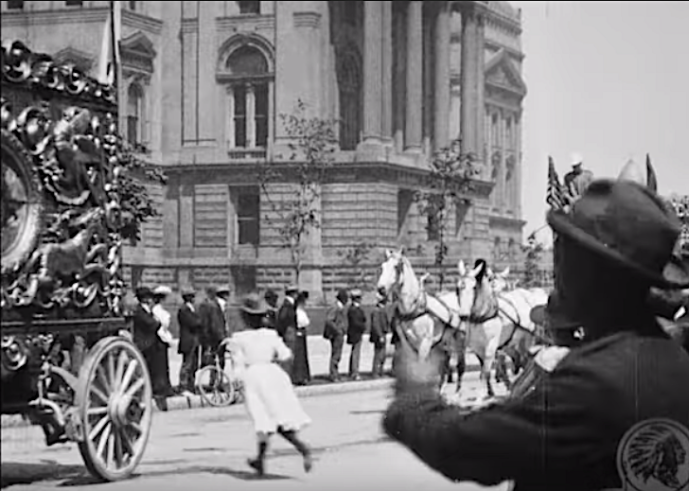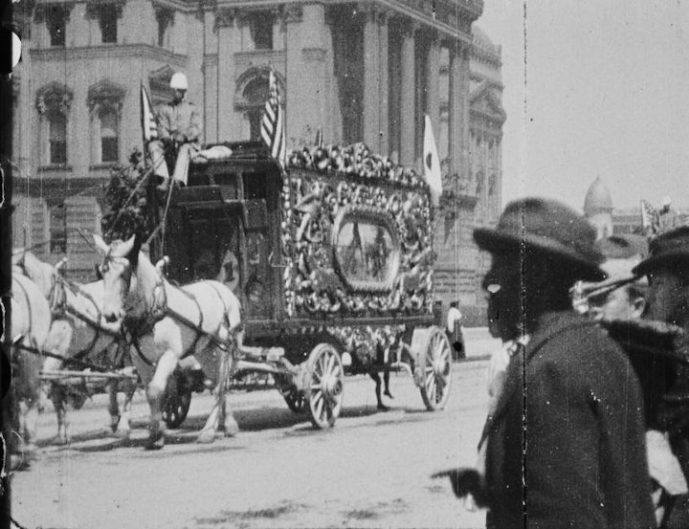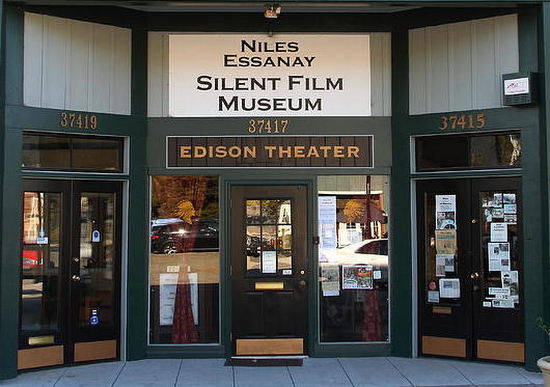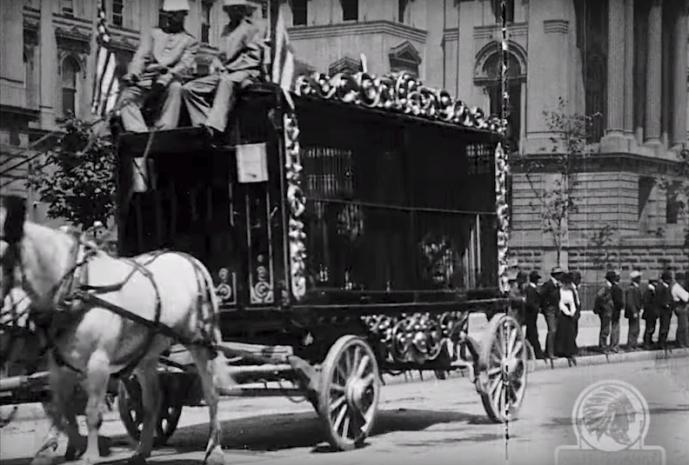When the Circus Came to Town, and Leapt from the Screen
Among the films just added to the National Film Registry is an extraordinary document from Indianapolis: a short film which shows the arrival in the city in 1902 of the Ringling Bros. Circus.
At that time, the run of performances by a circus as grand as the Ringling Brothers’ was clearly a major event, and whoever captured the company’s parade on film had an eye for the drama and grandeur of it.
The reel is just three minutes long, but full of riveting moments. A band plays atop a carriage — a bandwagon — whose tableau side panels cascade with figures of lions, dancers from the exotic East, and much else; drummers’ rataplan accompanies the brass. As one ornate carriage trundles in, drawn by four white horses, lions prowl inside its cage or crouch with menacing maw. What’s within the next three carriages is harder to tell — apparently they’re tigers, hyenas, and bears — but the creatures are large and turn with a dramatic effect that must have had children breathless along the route.
Men and women in costumes of many countries or circus versions of them, or spectacle jackets thick with brocade, jacket hooks, and other ornament, ride on horses and camels, and then come elephants each with a circus performer or worker riding on its head. Two charioteers in helmets and shining breastplates have come to town, too.
Circus boys, or perhaps they’re local children, stride alongside the carriages, holding onto them to signal their belonging or just to keep an arm’s length from crushing wagon wheels.
To viewers’ great good fortune, the institution that holds the film, the Niles Essanay Silent Film Museum in Fremont, California, across the bay from San Francisco, has posted the film on YouTube, with a commentary by archivist David Kiehn about the short film’s history, including the institution’s 5K transfer of it. How the Museum acquired the footage is a typical tale of film discovery serendipity. In August 2011, an elderly couple came to the museum with an unmarked film can they’d found in their basement 42 years earlier. The film within would turn out to provide a remarkable record of a circus parade at the turn of the century, and also to provide a rare glimpse of a prosperous northern Black community. The latter was one of two settings captured in the film. Among signs of prosperity is the wardrobe of the residents lining the street. Men and women in Sunday best. A spirited girl in stylish dress and hat navigates her way across the main street between the oncoming carriages.
As the National Film Preservation Board remarked in its announcement of the latest batch of 25 films added to the Library of Congress’s National Film Registry, African Americans rarely appeared in films of that era, and if they did, it was almost always in caricature or other demeaning distortions, through a white lens. “This eye-opening gem exemplifies how actuality films can unexpectedly capture time and place — fashions, ceremonies, locations soon to disappear, behavior at large events, and daily routines of life,” the NFPB observed.
Kiehn relates that when the donors brought the film to the Museum, he held the print up to the light and could immediately see images of a parade of some kind. Upon closer inspection he saw a circus rolling into a city somewhere in the US.
He set about determining the history of the film, starting with the location of the shoot. First he noticed that the perforations along the edge of the film stock were irregular in size and spacing. “They looked rather crude,” he explains in an introduction to the YouTube posting.
“That meant that the film was made sometime before 1910,” he says. That’s when Bell & Howell made a standardizing film perforator. “To this day, if you buy a roll of 35mm motion-picture film to put in a camera, it has Bell & Howell perforations. But this particular film did not.”
He found that the footage included two scenes: one with buildings that looked like government, downtown structures; the other a street scene with a “Park Theater,” a “Cleveland Club,” and a “Hendricks Café” that might reveal the location. He searched city directories and online to determine whether the Cleveland Club had been in Cleveland, Ohio, but could find no record of one there. He inspected the hand-carved wagons in the parade, and identified them from online records as from the Ringling Bros. circus.
He noticed an electric trolley-car line in the background of the parade, and a likely line name, “Blake.” “Over the years a lot of cities have put up their transit history, and I was surprised to find a Blake Street line in Indianapolis, Indiana,” he reports.
Kiehn was hot on the trail. In Indianapolis city directories of the early 20th century, he found that the city had had a Cleveland Club, but for just two years, 1902 and 1903.
Also online, he found the Ringling Bros. circus itinerary from the 1800s to the 1920s, and he discovered that the show had come to Indianapolis in 1902, not 1903, arriving in the city on 12 May. (This was before Ringling Bros. acquired Barnum and Bailey in 1906 and combined the two shows in 1919.)
“That seemed to pin down the date that the movie was filmed,” Kiehn says.
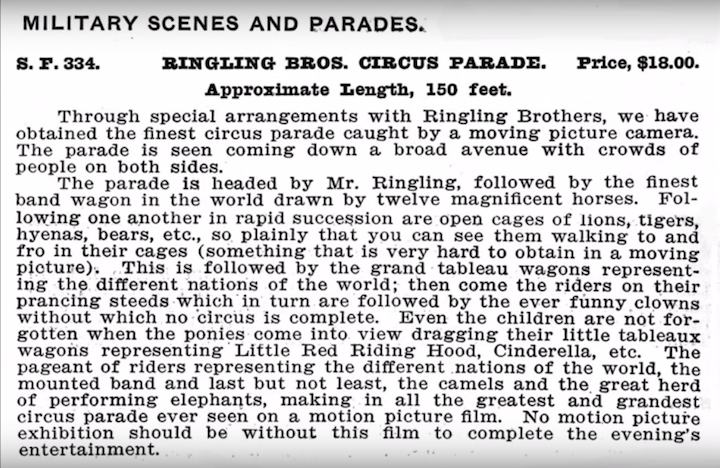 Then he found an entry from 1908 in a film catalog that the Niles Museum happened to have in its collection, and it included an advertisement for the film. It touted the film’s content – as “the greatest and grandest circus parade ever seen on a motion picture film.”
Then he found an entry from 1908 in a film catalog that the Niles Museum happened to have in its collection, and it included an advertisement for the film. It touted the film’s content – as “the greatest and grandest circus parade ever seen on a motion picture film.”
The film had been issued by the Selig Polyscope Company of Chicago in July 1902.
Recently restored by the Niles Essanay Silent Film Museum, this 3-minute actuality recording of a circus parade in Indianapolis in 1902 leaps from the screen. It’s well worth watching on as large a screen as you can.
— Peter Monaghan
Previous Post: Library of Congress adds 25 motion pictures to the National Film Registry
Next Post: Life Support for Medical Films

